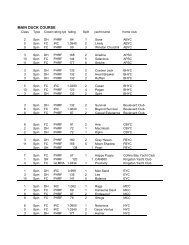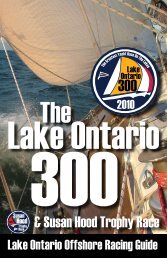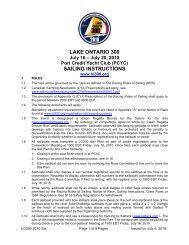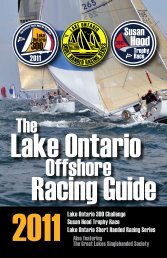LO300 Booklet 2010_04_09 Low RES - Lake Ontario 300
LO300 Booklet 2010_04_09 Low RES - Lake Ontario 300
LO300 Booklet 2010_04_09 Low RES - Lake Ontario 300
- No tags were found...
Create successful ePaper yourself
Turn your PDF publications into a flip-book with our unique Google optimized e-Paper software.
Page 22<strong>LO<strong>300</strong></strong>What Exactly isOffshore Racing Anyway?The <strong>Lake</strong> <strong>Ontario</strong> <strong>300</strong> is acknowledged as the longest annually held freshwater race in the world at <strong>300</strong> nautical miles and can be different things todifferent participants, taking on definitions ranging from an unbelievablethrill, the greatest challenge on the lakes, a marathon, an adventure, a test of skillsor for some a non-stop cruise.The <strong>LO<strong>300</strong></strong> is the Boston Marathon of <strong>Lake</strong> <strong>Ontario</strong>’s yachtingevents, but there are many other offshore raceshere that will challenge your sailing skills andambitions. These are listed on page 6 ofthis guide, and you can learn more aboutthem by contacting the host club or organizingauthority.Typically offshore racing refers to long distanceocean racing, but can apply to eventson large bodies of water such as the Great<strong>Lake</strong>s. Key features that help define an offshorerace include:1. A course without temporary marks adjustedto accommodate the wind.2. Long distance legs, usually at least 10 to 15 nm in length.3. Non-stop racing that frequently includes racing at night.4. Racing that is not postponed due to adverse weather conditions.Races that incorporate these attributes take on a personality of their own and ifthey are annual events, vary significantly year after year. The challenges differentfrom short course racing, requiring a different set of tactics, boat handling, and seamanshipskills. The skills needed vary dramatically depending on the time of yearduring which the race is run, it’s overall distance and the navigational obstaclesencountered on the course.Over longer distances, currentsmore of a factor and amplifyduring the race. Depending onyour boat may experience aimpacting performance forsame time, the longer distanceup lost time and/or distance.and uneven wind conditions becomethe effects of tactical decisions madeyour location to the rest of the fleetvery different weather pattern thusbetter or perhaps for worse. At theaffords greater opportunity to makeIn an offshore or long distance race<strong>LO<strong>300</strong></strong> <strong>Booklet</strong> <strong>2010</strong>_03_12 FINAL.indd 22<strong>09</strong>/<strong>04</strong>/<strong>2010</strong> 9:08:50 PM










